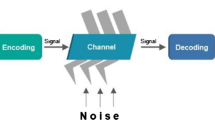Abstract
Some of the teething problems associated in the use of two-sensor noise cancellation systems are the nature of the noise signals—a problem that imposes the use of highly complex algorithms in reducing the noise. The usage of such methods can be impractical for many real time applications, where speed of convergence and processing time are critical. At the same time, the existing approaches are based on using a single, often complex adaptive filter to minimize noise, which has been determined to be inadequate and ineffective. In this paper, a new mechanism is proposed to reduce background noise from speech communications. The procedure is based on a two-sensor adaptive noise canceller that is capable of assigning an appropriate filter adapting to properties of the noise. The criterion to achieve this is based on measuring the eigenvalue spread based on the autocorrelation of the input noise. The proposed noise canceller (INC) applies an adaptive algorithm according to the characteristics of the input signal. Various experiments based on this technique using real-world signals are conducted to gauge the effectiveness of the approach. Initial results illustrated the system capabilities in executing noise cancellation under different types of environmental noise. The results based on the INC technique indicate fast convergence rates; improvements up to 30 dB in signal-to-noise ratio and at the same time shows 65% reduction of computational power compared to conventional method.







Similar content being viewed by others
References
Aboulnasr, T., & Mayyas, K. (1997). A robust variable step-size LMS-type algorithm: Analysis and simulations. IEEE Transactions on Signal Processing, 45, 631–639.
Bruno, M. J., Cousseau, J. E., & Donate, P. D. (2005). On reduced complexity IIR adaptive filters. In Proceeding of 2005 IEEE International Symposium on Circuits and Systems, Kobe, Japan (pp. 4329–4332).
Cheng, C., & Parhi, K. K. (2007). Low-cost parallel FIR filter structures with 2-stage parallelism. IEEE Transactions on Circuits and Systems I: Regular Papers, 54, 280–290.
Gonzalez, A., Ferrer, M., & Diego, M. D. (2012). An affine projection algorithm with variable step size and projection order. Digital Signal Processing, 22, 586–592.
Górriz, J. M., Ramírez, J., Puntonet, C. G., & Lang, E. W. (2009). A novel LMS algorithm applied to adaptive noise cancellation. IEEE Signal Processing Letters, 16, 34–37.
Greenberg, J. E. (1998). Modified LMS algorithms for speech processing with an adaptive noise canceller. IEEE Transactions on Speech and Audio Processing, 6, 338–351.
Haykin, S. (2002). Adaptive Filter Theory. New Jersey: Prentice Hall.
Huang, H. C., & Lee, J. (2012). A new variable step-size NLMS algorithm and its performance analysis. IEEE Transactions on Signal Processing, 60, 2055–2060.
Kim, S. E., Lee, J. W., & Song, W. J. (2011). A theory on the convergence behavior of the affine projection algorithm. IEEE Transactions on Signal Processing, 59, 6233–6239.
Manolakis, D. G., Ingle, V. K., & Kogon, S. M. (2000). Statistical and adaptive signal processing: Spectral estimation, signal modeling, adaptive filtering, and array processing. Massachusetts Artech House, Incorporated.
Mayyas, K., & Momani, F. (2011). An LMS adaptive algorithm with a new step-size control equation. Journal of the Franklin Institute, 348, 589–605.
Merched, R. (2003). Extended RLS lattice adaptive filters. IEEE Transactions on Signal Processing, 51, 2294–2309.
Merched, R., & Sayed, A. H. (2001). Extended fast fixed-order RLS adaptive filters. IEEE Transactions on Signal Processing, 49, 3015–3031.
Noor, A. O., Samad, S. A., & Hussain, A. (2012). Development of a voice activity controlled noise canceller. Sensors, 12, 6727–6745.
Okello, J., & Mizuno, M. (2003). An IIR ALE based on constrained FIR filter. IEICE Transactions on Fundamentals of Electronics, Communications and Computer Sciences, E86-A, 428–433.
Paul, T. K., & Ogunfunmi, T. (2011). On the convergence behavior of the affine projection algorithm for adaptive filters. IEEE Transactions on Circuits and Systems I: Regular Papers, 58, 1813–1826.
Ramli, R. M., Abid Noor, A. O., & Abdul Samad, S. (2012). A review of adaptive line enhancers for noise cancellation. Australian Journal of Basic and Applied Sciences, 6, 337–352.
Rossing, T. D. (2007). Handbook of acoustics. New York: Springer.
Sasaoka, N., Shimada, K., & Sonobe, S. (2009). Speech enhancement based on adaptive filter with variable step size for wideband and periodic noise. In Proceedings of 52nd IEEE International Midwest Symposium on Circuits and Systems, Cancun, Mexico (pp. 648–652).
Shin, H. C., Sayed, A. H., & Song, W. J. (2004). Variable step-size NLMS and affine projection algorithms. IEEE Signal Processing Letters, 11, 132–135.
Triki, M. (2009). Performance issues in recursive least-squares adaptive Gsc for speech enhancement. In Proceedings of IEEE International Conference on Acoustics, Speech and Signal Processing, Taipei, Taiwan (pp. 225–228).
Varga, A., & Steeneken, H. J. M. (1993). Assessment for automatic speech recognition: Ii. Noisex-92: A database and an experiment to study the effect of additive noise on speech recognition systems. Speech Communication, 12, 247–251.
Vega, L. R., Rey, H., & Benesty, J. (2010). A robust variable step-size affine projection algorithm. Signal Processing, 90, 2806–2810.
Widrow, B., Glover Jr., J, R., McCool, J. M., Kaunitz, J., Williams, C. S., Hearn, R. H., Zeidler, J. R. Jr., E, D., & Goodlin, R. C. (1975). Adaptive noise cancelling: Principles and applications. Proceedings of the IEEE, 63, 1692–1716.
Widrow, B., & Stearns, S. D. (1985). Adaptive signal processing. New Jersey: Prentice-Hall.
Yoo, J., Shin, J., & Park, P. (2015). An improved NLMS Algorithm in sparse systems against noisy input signals. IEEE Transactions on Circuits and Systems II: Express Briefs, 62, 271–275.
Author information
Authors and Affiliations
Corresponding author
Rights and permissions
About this article
Cite this article
Ramli, R.M., Noor, A.O.A. & Abdul Samad, S. Noise cancellation using selectable adaptive algorithm for speech in variable noise environment. Int J Speech Technol 20, 535–542 (2017). https://doi.org/10.1007/s10772-017-9425-1
Received:
Accepted:
Published:
Issue Date:
DOI: https://doi.org/10.1007/s10772-017-9425-1




